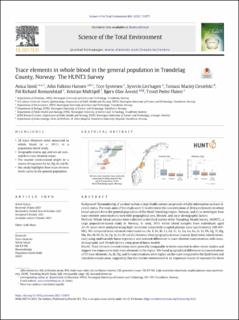| dc.description.abstract | Background: Biomonitoring of a cohort within a large health survey can provide reliable information on trace element status. The main aims of this study were 1) to determine the concentrations of 28 trace elements in whole blood samples from the general population of the Nord-Trøndelag region, Norway, and 2) to investigate how trace element concentrations vary with geographical area, lifestyle, and socio-demographic factors. Methods: Whole blood samples were collected in the third survey of the Trøndelag Health Survey (HUNT3), a large population-based study in Norway. In total, 1011 whole blood samples from individuals aged 20-91 years were analyzed using high resolution inductively coupled plasma-mass spectrometry (HR-ICP-MS). We compared trace element concentrations (As, B, Be, Br, Ca, Cd, Cr, Cs, Cu, Ga, Au, In, Fe, Pb, Hg, Tl, Mg, Mn, Mo, Ni, Rb, Sc, Se, Ag, Sr, Sn, W and Zn) between three geographical areas (coastal, fjord/town, inland/mountain) using multivariable linear regression and assessed differences in trace element concentrations with socio-demographic and lifestyle factors using general linear models. Results: Trace element concentrations were generally comparable to levels reported in other recent studies and suggest low exposure to toxic trace elements in the region. We found geographical differences in concentrations of 19 trace elements. As, Br, Hg, and Se concentrations were higher on the coast compared to the fjord/town and inland/mountain areas, suggesting that the marine environment is an important source of exposure for these trace elements. In addition, socio-demographic and lifestyle characteristics, particularly age and sex, were associated with differences in trace element concentrations. Conclusions: We report concentrations of 28 trace elements in the general population of a rural region with low exposure to pollution. Whole blood concentrations of trace elements varied with geographical area, the participants' lifestyle, and socio-demographic characteristics, highlighting the importance of considering these factors when evaluating trace element status in a population. | en_US |

